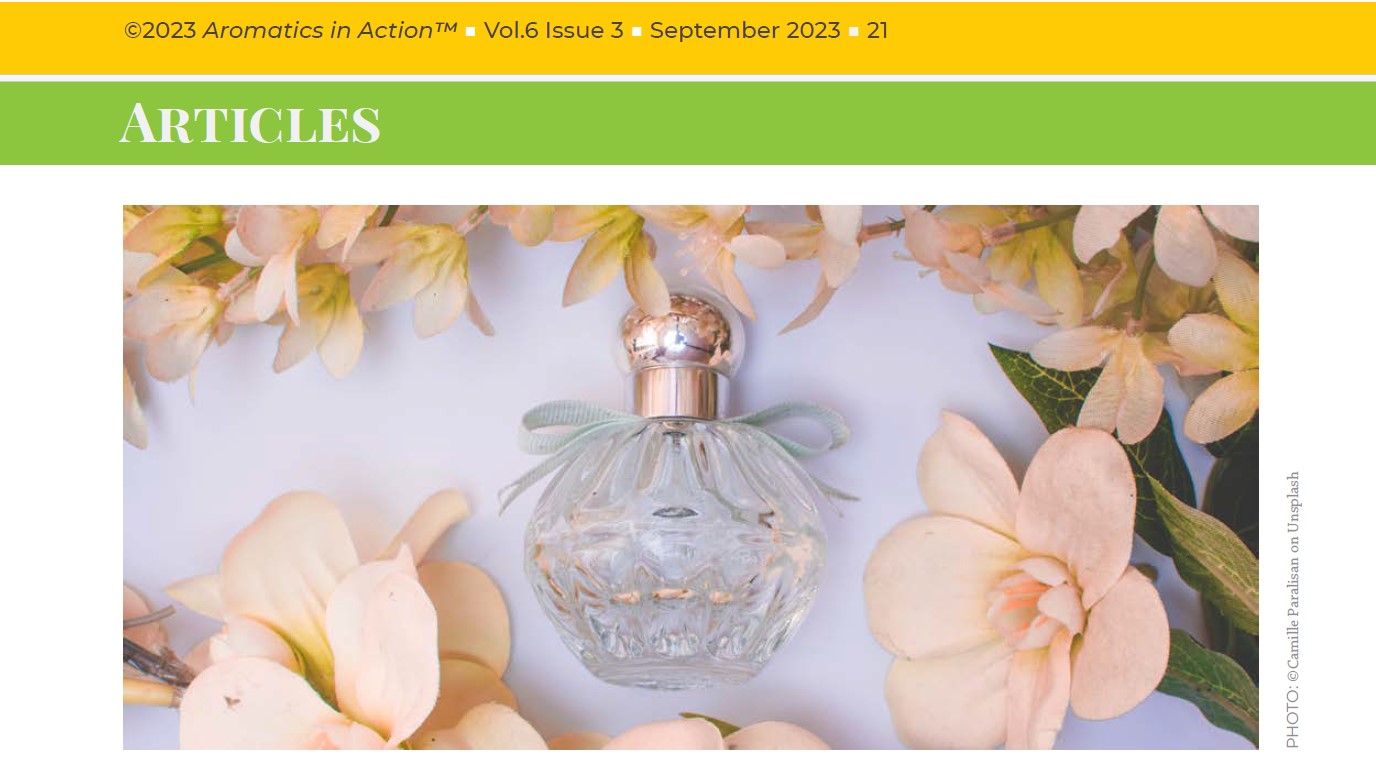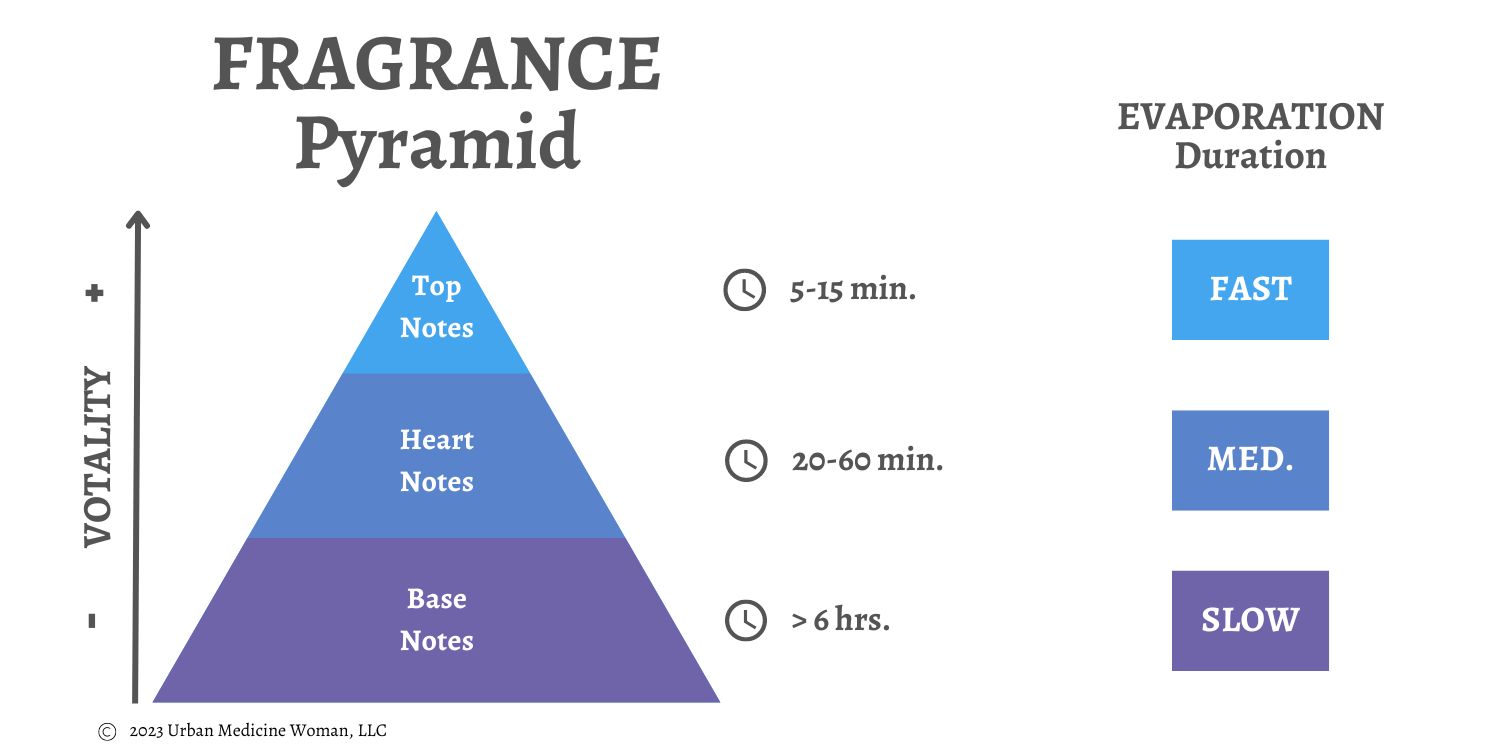Article (AIA) - The Art of Natural Perfumery

The Art of Natural Perfumery: Exploring the
Connection Between Scent, Emotions, and Health
Perfume's ancient allure persists, gaining momentum
during the pandemic. As we prioritize well-being,
natural perfumery offers sustainable alternatives. The
profound link between scent and emotions inspires
harmonious blends for joy and balance. Discover the
transformative power of signature scents–embrace
the art of perfume for a healthier, happier you.
From Ancient Egypt to Modern
Times: The Rich History of Perfume
Perfume has a rich history dating as far back as 3000
BC with the ancient Egyptians and Mesopotamians.
These perfumes were made completely from plant
material combined with a carrier oil like Olive oil. One
popular perfume in ancient Egypt was Kyphi–made of
Frankincense, Myrrh, Mastic, Pine, and other resins
steeped in oil. Perfume and cosmetics were not only
common in their celebration of life, but played a part
in the preparation for the afterlife. This practice ensured the body was pleasing to the gods when entering the afterlife (Mark, 2017).
Today, perfume still has a prominent part in the beauty
industry and it continues to grow. One of the most
significant growth periods came during the COVID-19
pandemic. Fragrance became an “affordable luxury”
and sales increased nearly 45% in the first quarter of
2021 (Hartmans, 2021). Millions of people searched to
escape the confined and anxious energy created by
the pandemic. Now that the fear is less, the focus on
health and prevention is prominent.
Natural Perfumery: The Intersection
of Fragrance and Medicinal Benefits
The connection between smell and memory is remarkably strong, and fragrance serves as a link to joyful memories. Natural perfumery is experiencing a resurgence in popularity as consumers seek more sustainable and eco-friendly alternatives to traditional perfumes. The use of essential oils continues to rise. Although there is a trend to marry perfume and traditional aromatherapy, the word “perfume” is still not embraced in the essential oil community. Let’s explore their differences and similarities.
Perfume aims to create a heightened emotional
experience, setting it apart from traditional aromatherapy, although they share many similarities.
Traditional aromatherapy is centered on harmonizing
or balancing something within. Essential oils penetrate
the skin and are absorbed into the circulatory system.
They work on more of a long-term basis, contributing
to the body strengthening from within. It’s not completely about the pleasant aroma. For instance, Cistus (Cistus ladanifer) essential oil is great support in healing minor skin wounds and insect bites. I feel it is not the most pleasing scent because it is quite musky and intense. Although, it is a popular ingredient in incense–creating a perfume like experience.
Additionally, synthetic fragrance compounds and
other ingredients like alcohol, gained prominence in
the 19th century.
When it comes to perfumes, those containing alcohol
don't deeply penetrate the skin and tend to evaporate
rapidly. However, there are different types of perfumes with varying concentrations of essential oils. Parfum typically contains a higher percentage, ranging from 20% to 30% essential oil content. Moving down the scale, Eau de Parfum falls within the range of 8% to
15% essential oils, while Eau de Toilette typically contains 4% to 8% essential oils. It's worth mentioning that other popular fragrance options are: Eau de Cologne, which generally contains a lower concentration of essential oils, usually around 2% to 5%, and Eau Fraîche with an even lower concentration at 1% to 3%, making them lighter and more refreshing (Venables, 2022).
The Power of Scent: Tapping into
Emotional Well-being
Both perfume and aromatherapy potentially have a
similar outcome. If the heightened emotional experience
that perfume offers is a positive, then it does have a
medicinal value. Chemicals like serotonin, dopamine,
and endorphins, known as the happy hormones, play a
significant role in happiness (Watson, 2021).

The power of scent and how it taps into our emotional
body is fascinating. How does this scent make you feel?
The greatest medicine and balancing agent in your
body is your emotional response. YOU! The simplest
concepts are often overlooked in Western culture, while other cultures celebrate simplicity. "There is no way to happiness. Happiness is the way" (Hanh, 1991).
Combining aromatherapy with the art of perfume,
natural perfume is the best of both. Perfumes are
completely about scent. Different scents can create
different experiences. For instance, a blend of essential
oils including Ylang Ylang (Cananga odorata), Sandalwood* (Santalum album), and Cinnamon bark (Cinnamomun zeylanicum) can create a sensual experience. All three essential oils are considered to have aphrodisiac qualities. Natural perfumes create an experience with medicinal benefits.
The fun part, for me, is building this experience. What is involved in the process of building a natural perfume?
What is your intention? What experience do you want
to create? What is the emotional outcome you are
looking for? The best essential oils for natural perfumery depend on personal preference and the desired therapeutic benefits. Once these decisions are made, then we can match the desired outcome with the proper oils, always considering the aromatic affects. Some popular essential oils used in natural perfumery include: the absolutes Rose (Rosa damascene) and Jasmine (Jasminum grandiflorum), and essential oils Ylang Ylang (Cananga odorata), Bergamot (Citrus bergamia), Sandalwood* (Santalum album), Patchouli (Pogosteamon cablin), Lavender (Lavandula angustifolia), and Lemon (Citrus limonum).
The Symphony of Fragrance: Top,
Middle, and Base Notes Explained
When creating fragrant blends, it's important to consider the top, middle, and base notes of each essential oil. This ensures that the scent is well-balanced and long-lasting. Perfumers explain their fragrance with the image of a pyramid. the most volatile smells are top notes and the least volatile ones are the base notes. The main theme of the fragrance, also known as the heart, is the middle note (Salomon, 2020).
Just like a symphony, each note in a perfume blend dissipates at a different rate, creating a harmonious melody. The top note is your first impression, the aroma that hits you immediately. These notes have a lighter molecular structure, therefore do not last long, maybe 5 to 15 minutes. They make up about 20% of the blend. The citrus oils
are a good example. Some of my favorite top note essential oils are Grapefruit (Citrus paradisi), Lemon (Citrus
limonum), and Bergamot (Citrus bergamia).
The middle note is the heart of the fragrance, the main theme lasting 20-60 minutes. Once the initial fragrance
leaves, the middle note comes in. This note is the most dominant overall scent. It makes up 70% of the scent.
Floral scents are most common. My favorites are the absolute Rose (Rosa damascene), and the essential oils Neroli
(Citrus auratium), Geranium (Pelargonium graveolens), and Lavender (Lavandula angustifolia).
Lastly, the base notes are the notes that linger and last the longest. Due to their heavier molecular structure, they can last up to 6 hours. They make up about 10% of the blend. These notes are usually earthy, deep scents. My favorites are the absolute Rose (Rosa damascene), and the essential oils Vetiver (Vetiveria zizanoides) and Sandalwood (Santalum album).

Creating a Harmonious Blend:
Crafting a Light, Earthy Floral Fragrance for Emotional Transitions
Combining essential oils with
a carrier oil that nourishes the
skin creates a perfect synergy
of conventional perfume and
aromatherapy intentions.
Following the pyramid analogy, let's create a natural perfume blend—a light, earthy, floral fragrance that can wonderfully address major emotional and physical transitions. As Victor Hugo said "Every plant is a lamp. Perfume is the light." (Delacourte, 2021).
Combine:
◆ (Top Note) - 4 drops Lemon (Citrus limonum) essential oil
◆ (Middle Note) - 15 drops Geranium (Pelargonium graveolens) essential oil
◆ (Base Note) - 1 drop Rose (Rosa damascene) absolute
You can use a drop or two of this blend neat on your wrists or combine with a nourishing carrier oil such
Coconut (Cocos nucifera), Grapeseed (Vitis vinifera), or my favorite, Jojoba (Simmondsia chinensis).
Suggested dilution rate is 5%. Do a patch test first to find your sensitivity level.
I have been working one-on-one with clients for over 15 years. My advice is to “find you!” Find the scent that
resonates with you. I resonate on the simple side.
In conclusion, perfume is an art that bridges ancient traditions with modern desires for joy and wellness. From
its rich history, to its rise during the pandemic, perfume has captured our fascination. Combining fragrance and
therapeutic benefits, natural perfumery offers a sustainable alternative. By understanding fragrance notes and
personal intentions, we can create harmonious blends. Discovering your signature scent allows you to embrace
the transformative power of fragrance and find happiness in simplicity.
*Sandalwood East India (Santalum album), is a valuable and highly prized tree and there is a growing concern
about the sustainability of the Sandalwood industry. Unsustainable practices could endanger its future and harm
our environment and communities. The Indian government has a number of policies and programs in place to
control the production of Sandalwood in East India such as The Sandalwood Act of 1964 and the creation of The
Sandalwood Development Board in 2013.
References
Delacourte S. (2021) Perfume quotes. Sylvaine Delacourte’s blog. Retrieved from https://www.sylvaine-delacourte.com/en/blog/perfumequotes
Hanh, T. (1991). Peace is every step: the path of mindfulness in everyday life. Random House.
Hartmans A. (2021, June 03) Fragrances become an affordable luxury during the pandemic, leading to the biggest boom in sales in years. Business insider. Retrieved from https://www.businessinsider.com/fragrance-sales-increasing-during-pandemic-explained-2021-6
Mark, J. J. (2017, May 04). Cosmetics, perfume, & hygiene in ancient egypt. World History Encyclopedia. Retrieved from https://www.worldhistory.org/article/1061/cosmetics-perfume--hygiene-in-ancient-egypt/
Salomon G. (2020, November 13) What are fragrance notes? Top, Middle and Base Notes. ACS packaging. Retrieved from https://www.acspack.co.za/what-are-fragrance-notes-top-middle-base-notes/
Venables E. (2022, October 03). Perfume concentration guide : Eau de toilette, eau de parfum & parfum. The perfume shop. Retrieved from https://www.theperfumeshop.com/blog/expertise/whats-the-difference-between-parfum-and-eau-de-parfum/
Watson S. (2021, July 20) Feel-good hormones: How they affect your mind, mood and body. Harvard health publishing. Harvard medical school. Retrieved from https://www.health.harvard.edu/mind-and-mood/feel-good-hormones-how-they-affect-your-mind-moodand-body


